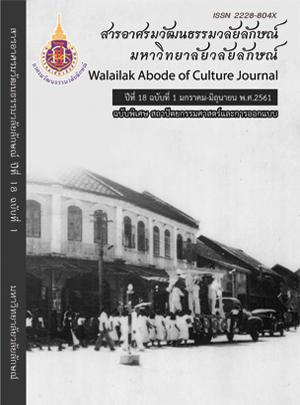A Study of Sound Absorption Ability of Fiberboard from Palmyra Peel
Abstract
The objective of the research is to study fiberboard from palmyra palm peel for sound absorbance. The experiment will study the appropriate lengths of fiber and sizes for fiberboard (thickness: 2 inch, size 10 x 10 cm, 15 x 15 cm, and 20 x 20 cm) to get the performance to absorb sound, and study in the frequency range of the human ear can be perceived well is the range of 400-4000 Hz.
The result of the test shows that ability to absorb sound of fiber from palmyra palm peel at 2 inches thickness. There are 2 types of Wallboard: the first form; Cutting the fibers from the eyelids to give the fibers have a uniform length of the line and for the adhesion of the binder. The second form; is the fiber has not undergone any cutting process, using the length of the fiber. It was found that the fibreboard from palmyra palm peel can absorb sound at 400 - 1,400 Hz. the first form, absorption capacity is 400 - 1,200 Hz or 2.6 - 7.8 dB. the first form, the sound absorption capacity is 400 - 1,400 Hz or 2.6 - 9 dB.
The results showed that fiber cutting results in sound absorbing performance less than does not cutting the fiber, the size and thickness cause the several unique styles placement of the fibreboard from palmyra palm.
References
Hancharoen, K. (2013). Kan wat kha sa phap kan nam khwam ro̜n kho̜ng chanuan kan khwam ro̜n chak senyai sapparot duai withikan so̜p klap thang trong [Measuring Thermal Conductivity of Thermal Insulation fromCellulose Fiber of Pineapple by The Direct Traceability Method]. (Master’ Thesis, Kasetsart University).
Kudngaongarm, P. (2006). Kanphalit phæn phanang phainai akhan thi tham chak ton thup [Production of Interior Partition from Typha sp ; Family Thphaceae]. (Master’s Thesis, Kasetsart University.
Nor, M.J.M., Jamaludin, N. & Tamiri, F.M. (2004). A preliminary study of 70 sound absorption using multi-layer coconut coir fiber. Malaysia: University Kebangsaan Malaysia.
Phisudsiang, C. (2011). Prasitthiphap kan po̜ngkan khwam ro̜n kho̜ng chanuan bai yangphara [Energy - Efficient of insulation produced from rubber leaf]. (Master Thesis, Chulalongkorn University).
Ratanakorn, S. (2015). Kanphalit phæn chanuan kan khwam ro̜n chak senyai luktan [Thermal Insulation Produced from Sugar Palm Fiber]. (Master’s Thesis, Kasetsart University).
Siripetch, P. (2007). Phæn dutsap siang chak sang khaophot [Sound absorption Material from corn cob]. (Master’s Thesis, Kasetsart University).
Suriyan, S. (2007). Phæn chanuan kan siang chak yai maphrao [Sound Insulation Material from Coconut Fiber]. (Master’s Thesis, Kasetsart University).
Sharp, B.H. (1978). Prediction Methods for the Sound Transmission of Building Elements. Noise Control Engineering, 11(2), 53-63.
Thanompong, T. (2009). Senyai thang bai pam at phæn samrap dut sap siang [Palm Fiber Acoustic Board]. (Master’s Thesis, Kasetsart University).
Downloads
Published
How to Cite
Issue
Section
License
© 2018 by Asian Journal of Arts and Culture, Walailak University. All rights reserved.




